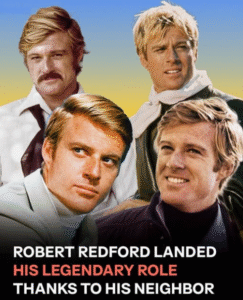Robert Redford Originally Pursued a Different Career Before Becoming an Actor
Robert Redford, the iconic Hollywood actor, director, and producer, is widely celebrated for his performances in classics like Butch Cassidy and the Sundance Kid, The Sting, and All the President’s Men. He is also the founder of the Sundance Film Festival, a major platform for independent filmmakers. While his life and career are closely associated with acting and filmmaking, few know that Redford’s original aspirations lay in an entirely different field.
Early Life and Education
Born Charles Robert Redford Jr. on August 18, 1936, in Santa Monica, California, Redford was the only child of Martha Hart and Charles Robert Redford Sr. He grew up in a suburban environment where creativity and education were emphasized. His mother, a teacher, and his father, a paper manufacturer, encouraged intellectual curiosity, which influenced Redford’s early interests.
As a child, Redford showed an early interest in the arts, but his focus was not initially on acting. He attended Van Nuys High School in California, where he participated in sports and student activities. These early experiences would later inform his well-rounded approach to performance and his ability to portray physically and emotionally demanding roles.
After high school, Redford enrolled at the University of Colorado Boulder. There, he pursued a degree in journalism, demonstrating a keen interest in storytelling and communication. His studies in journalism reflected a desire to engage with the world through writing and reporting, rather than performance. Redford himself later remarked that he was initially drawn to a career that combined creativity with practical skills.
The Shift Toward Art and Design
During his time at university, Redford developed a fascination with visual arts. He began taking painting and design classes, ultimately deciding to transfer to the Pratt Institute in New York, one of the country’s leading art schools. At Pratt, he studied painting and sculpture, immersing himself in the techniques and philosophies of fine art.
Redford also attended the American Academy of Dramatic Arts in New York, which marked a turning point in his career path. While his initial goal was to pursue visual arts professionally, exposure to the world of theater and performance captivated him. His charisma, physical presence, and talent for expressive movement made him a natural on stage, and he began to consider acting as a viable career.
Early Career Aspirations
Before committing fully to acting, Redford’s ambitions were firmly rooted in art and design. He imagined a life as a painter or sculptor, hoping to exhibit his work in galleries and develop a reputation in the fine arts world. This background in visual arts would later influence his approach to filmmaking, particularly his meticulous attention to framing, lighting, and visual storytelling in his directorial projects.
Redford’s understanding of composition and aesthetics allowed him to bring a unique sensibility to his roles in front of the camera and later behind it as a director. His early artistic training cultivated a disciplined work ethic and a deep appreciation for creativity, both of which became hallmarks of his career in Hollywood.
The Leap Into Acting
Despite his love for visual art, Redford’s exposure to the theater world convinced him to explore acting more seriously. He began auditioning for roles in New York stage productions, honing his skills and learning the nuances of performance. Early roles included work in off-Broadway productions, television appearances, and small film parts.
His talent quickly became evident, and by the early 1960s, Redford was gaining recognition for his performances in television series such as Naked City and The Untouchables. His athleticism, combined with a natural screen presence, allowed him to transition seamlessly from stage to screen.
Redford’s big break came in the mid-1960s when he starred in films like War Hunt (1962) and Barefoot in the Park (1967). His collaboration with director Sydney Pollack and co-stars such as Paul Newman established him as a rising talent in Hollywood. The transition from aspiring visual artist to acclaimed actor was complete, though he never abandoned his artistic sensibilities.
How His Artistic Background Influenced His Film Career
Redford’s early pursuit of art had a profound influence on his approach to acting and filmmaking. His understanding of visual composition and attention to detail allowed him to collaborate effectively with directors and cinematographers. He often emphasized the importance of lighting, framing, and set design, ensuring that each scene contributed to the story’s emotional impact.
As a director, Redford’s artistic background became even more evident. Films such as Ordinary People (1980), which won the Academy Award for Best Picture, display a painterly attention to visual storytelling. His ability to balance narrative and aesthetics can be traced back to his original aspirations in the world of visual arts.
Moreover, Redford’s appreciation for aesthetics extended beyond his own work. He founded the Sundance Institute and the Sundance Film Festival to support independent filmmakers who might otherwise be overlooked, championing creative vision and innovation in cinema. His commitment to nurturing artistic expression reflects the values he first embraced as an aspiring painter and designer.
Reflections on Career Transformation
Redford has often reflected on the unconventional path that led him from visual arts to acting and filmmaking. He has spoken about the importance of remaining open to new experiences and following one’s passions, even when they diverge from original plans. In interviews, he emphasizes that his early artistic pursuits were never wasted; rather, they provided a foundation for his later success in Hollywood.
He also highlights the value of adaptability and lifelong learning. By embracing acting, Redford discovered a new form of storytelling that allowed him to combine visual aesthetics, emotional depth, and performance in a unique way. His journey demonstrates that career paths are not always linear and that skills developed in one domain can enrich achievements in another.
Legacy and Impact
Today, Robert Redford is remembered not only as a celebrated actor but also as a visionary director, producer, and advocate for independent film. His original pursuit of art may have been redirected, but its influence permeates his work. He has inspired generations of actors, filmmakers, and artists to explore multiple forms of expression, blending disciplines to create meaningful, impactful work.
Redford’s story serves as a reminder that initial career goals do not define one’s ultimate potential. Passion, creativity, and dedication can lead to unforeseen opportunities, resulting in a life of accomplishment and influence that transcends original expectations.
Conclusion
Robert Redford’s journey from aspiring painter and designer to Hollywood icon illustrates the unpredictable yet rewarding nature of pursuing one’s passions. While he initially aimed for a career in visual arts, his foray into acting opened doors to creative opportunities that allowed him to shape the world of cinema.
His artistic sensibility, cultivated during his early years in art school, continues to inform his work and legacy. By embracing change and following his evolving interests, Redford transformed his initial aspirations into a lifelong career that has left an indelible mark on film, theater, and independent cinema.
Redford’s story encourages individuals to remain open to new experiences, trust their instincts, and recognize that skills developed in one arena can have profound applications in another. It’s a testament to the power of adaptability, creativity, and perseverance—principles that have guided Redford from the art studios of his youth to the heights of Hollywood acclaim.


